Lithium-ion battery analysis: The Panasonic battery used by Tesla is a kind of lithium-ion battery. A lithium ion battery is a secondary battery (rechargeable battery) that mainly relies on lithium ions moving between a positive electrode and a negative electrode to operate. During charge and discharge, Li + is intercalated and deintercalated between the two electrodes: when charging, Li + is deintercalated from the positive electrode, and the electrolyte is inserted into the negative electrode, and the negative electrode is in a lithium-rich state; when discharged, the opposite is true. The battery generally uses a material containing lithium as an electrode.

Its main advantages are high output voltage (3.6V), high energy density, small self-discharge, long cycle life, no memory effect, fast charge and discharge, and no toxic and harmful substances. The disadvantage is that temperature affects battery capacity and poor safety. At present, the main application areas are consumer electronics, electric vehicles, large power supplies, and secondary charging and energy storage.
Panasonic 18650 battery for Tesla Model S
18650 is the originator of lithium-ion battery--a standard lithium-ion battery model that Japan SONY Company set in order to save cost. Among them, 18 means diameter 18mm, 65 means length is 65mm, 0 means cylindrical battery.
The Model 18650 battery used by Model S is a Panasonic ternary material battery of NCR18650B with a capacitance of approximately 3.3 mA, a voltage of 3.6 V, and an energy density of 243 Wh/kg.
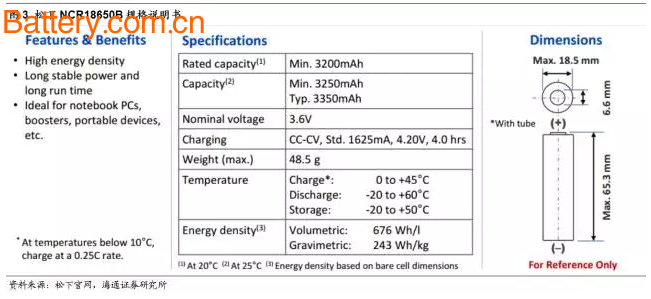
The NCR18650B used on Tesla's Model S is 30% more powerful than the lithium cobalt oxide battery used by the previous Roadster. The difference is due to the difference in structure. It uses nickel-cobalt-aluminum ternary material as the positive electrode material and graphite as the negative electrode. The material is lithium hexafluorophosphate as the electrolyte. In the end, it achieves a greater than energy, stability and consistency. In addition, the single cell has a small size but high controllability, which can reduce the impact of a single battery failure, even if a unit of the battery pack fails, it will not affect the overall performance of the battery.
The structure of lithium batteries is various, and Panasonic ternary batteries are just one of them. Below we will mainly analyze lithium batteries in detail from the five core components of lithium batteries.
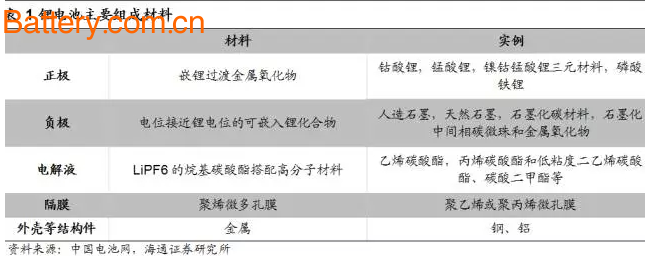
Cathode material
The positive electrode material determines the main properties of the lithium ion battery, such as energy density, cycle stability, safety, and the like. The cathode material currently mainly includes lithium cobaltate, lithium manganate, lithium iron phosphate and ternary materials. At present, the positive electrode of lithium battery follows the development trend from binary material to ternary material. The cathode material of Panasonic NRC18650B is nickel-cobalt-aluminum ternary material, commonly known as NCA.
By introducing the Ni content, the capacity of the material can be increased, and the Panasonic NRC18650B increases the Ni content (molar fraction of 80%), thereby increasing the battery from the original 2.9 Ah to about 3.3 Ah, and the energy density is greatly improved. At the same time benefiting from the ternary synergy effect, NCA cathode materials combine many advantages of LiNiO 2 and LiCoO 2 , and the performance is superior to the use of a single material. Moreover, the material uses less cobalt and is less expensive.

From the current market point of view, lithium iron phosphate and ternary materials are the two most mainstream cathode materials in China. Due to the large demand for lithium iron phosphate batteries in new energy buses , the market share of lithium iron phosphate is higher. However, the ternary materials have gradually developed with a relatively rapid momentum and become the future trend.

Whether it is lithium iron phosphate cathode material or ternary cathode material, lithium carbonate is inseparable. Taking Tesla Model S as an example to measure the lithium carbonate equivalent demand of a new energy vehicle: Panasonic NCR18650 battery cell weight 44g, Panasonic official website shows that the positive electrode material weight in the 18650 battery accounted for 20~35%, assuming that its cathode material is 30 About %, the weight is about 15 grams. The NCA chemical formula Li(Ni 0.8 Co 0.15 Al 0.05 )xO 2 has a molecular weight of 87.5 as measured by x=0.845; the lithium carbonate has a molecular formula of Li 2 CO 3 and a molecular weight of 74. According to the lithium element one to one, the weight ratio of the two is 74: (87.5 × 2) = 0.423: 1.
It can be seen that 1 gram of lithium cobalt nickel aluminum ternary positive electrode material requires 0.423 g of lithium carbonate. The production of a 18650NCA ternary battery cathode material requires 15*0.423=6.345g lithium carbonate. A ModelS uses 7104 18650 batteries, equivalent to lithium carbonate equivalent = 7104 * 6.345g = 45.1kg, plus the electrolyte lithium hexafluorophosphate demand for lithium carbonate and industrial wear, it is estimated that a ModelS lithium carbonate equivalent demand is about 60kg The equivalent consumption is 0.73kg/kWh.
Calculated according to the same idea, we estimate that the nickel element consumption of the Panasonic ternary battery is about 0.53kg/kWh.
In addition, cobalt is also an indispensable upstream raw material for NCA and NCM ternary materials. As the substitution trend of ternary materials for lithium iron carbonate becomes more and more clear, the demand for cobalt also rises. The demand for cobalt in the NCA ternary material is about 0.14 kg/kWh.
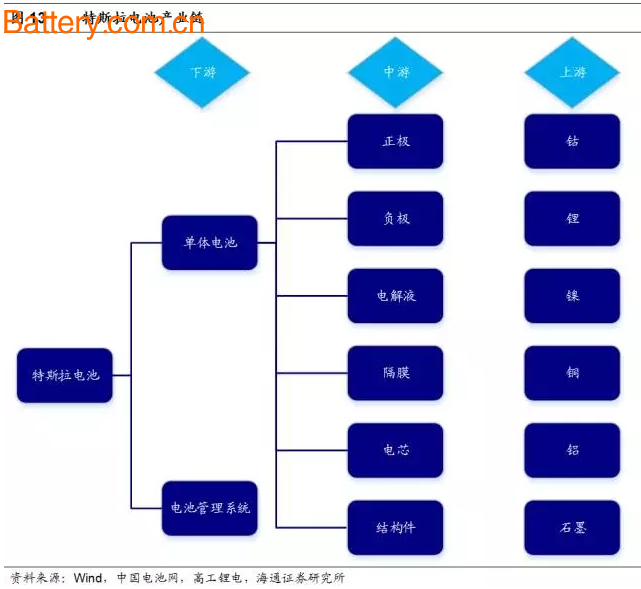
Anode material
Graphite is still the first choice for anode materials
The negative electrode of the lithium ion battery is made by mixing a negative electrode active material carbon material or a non-carbon material, a binder and an additive to form a paste adhesive, which is evenly coated on both sides of the copper foil, and dried and rolled. The negative electrode material is a main body for storing lithium in a lithium ion battery, so that lithium ions are inserted and removed during charging and discharging.
The negative electrode materials are mainly classified into the following three types: carbon materials (graphites), metal oxide materials, and alloy materials. The anode material of the Panasonic NCR18650B battery is made of graphite.
Since the outbreak of the power battery market, the price of the anode material is relatively stable compared to other materials, and the technical route is mainly graphite, and there is no big controversy. According to China Battery Network data, taking a power lithium battery as an example, a new energy vehicle needs about 40 kilograms of anode material, and the graphite consumption is about 0.9kg/kWh. At present, the negative electrode materials are mainly composed of natural graphite and artificial graphite, and their performances have their own advantages and disadvantages, and the application fields are also different.

The most advanced product in the development of carbon materials is graphene, which is the thinnest layered material discovered so far, and the capacity of the battery can be increased by using graphene as a negative electrode material. The upper limit of energy density (graphene) of conventional graphite materials is 372 mAh/g, which is quite marginal than the energy density of current cathode materials. In the future, improving the energy density of power batteries is still the key to the power of new energy vehicles. Although expensive or technically immature, high-end anode materials such as lithium titanate and silicon-based composite materials are gradually entering the application field of anode materials.
Silicon-based anode: the trend of lithium battery anode
The biggest advantage of Si-based anode materials is the extremely high theoretical energy density (4200 mAh/g), which is much higher than graphite. This is also in line with the requirements of new energy vehicles for batteries. From the current trend, the future development of anode materials will be directed to silicon + graphite, and finally pure silicon / metal lithium will completely replace low energy density graphite.
The biggest shortcoming of the silicon-based anode material is the expansion problem, which is easy to expand and break after charging, and cannot be restored, resulting in the final powdering of the material, which greatly shortens the battery life.
There is 300% expansion during charging and discharging, and only 7% of graphite under the same conditions. At present, the content of silicon in the negative electrode of the carbon-based composite material newly developed by Panasonic has reached 10%. It can be seen that there is still much room for development with the advancement of the technical level.
Negative current collector: lithium battery copper foil
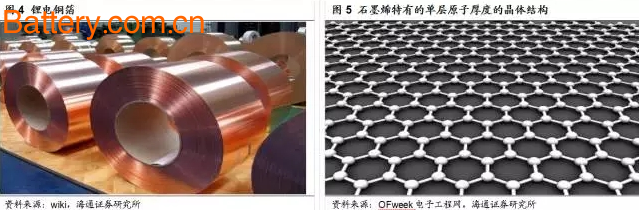
According to the different production processes, the copper foil is further divided into a rolled copper foil and an electrolytic copper foil, and the rolled copper foil is generally used as a building decoration material. Because copper foil has good electrical conductivity, soft texture, good ductility and easy processing and deformation, it is also the material of choice for making anode current collectors for lithium batteries. The function of the lithium ion battery current collector is to collect the current generated by the battery active material to form a large current output. Therefore, the current collector should have a lower specific surface energy and thus be easily in contact with the active material, and have excellent electrical conductivity. Sex.
At present, most domestic and foreign lithium battery manufacturers use electrolytic copper foil as the anode current collector of lithium batteries. In recent years, the rapid development of new energy vehicles has led to a rapid increase in the demand for lithium batteries required for new energy vehicles. Copper foil is an important raw material for lithium batteries, and its demand is of course increased, so new energy vehicles The development led to the development of lithium copper foil, which has a negligible impact on the entire copper foil industry.

The development of new energy industry has led to great changes in the production and sales structure of copper foil products in China. The production capacity of lithium copper foil has increased from 59,000 tons in 2015 to 70,300 tons in 2016; the proportion of production has increased from 10.35% in 2013 to 2016. 20.2%. Prior to 2013, lithium-ion copper foil was mainly used in consumer electronics such as digital products, but it was slowly applied to power batteries, and the proportion gradually increased.
In lithium batteries, the consumption of copper foil is approximately 0.9 kg/kWh. According to the data of copper crown and copper foil, the capacity of lithium copper foil in China is 70,300 tons in 2016, and the demand for lithium copper foil will rise to 80,000 tons in 2017, the supply gap is obvious. Due to the long construction period of the new lithium-ion copper foil project, which is about 24 months, it is very difficult to make up for the gap. The copper foil processing fee continues to rise under the support of rigid demand.
Electrolyte
The electrolyte is a carrier for driving lithium ions in a lithium ion battery, and plays an important role in the operation and safety of the lithium battery. The working principle of lithium-ion battery is also the process of charging and discharging, which is characterized by the lithium ion passing between the positive and negative electrodes, and the electrolyte is the medium for lithium ion flow.
According to the calculation of China's battery network , in the cost structure of the electrolyte, the solvent accounts for about 30%, the additive accounts for about 10%, and the most important component solute accounts for about 60%. The solute on the market is mainly lithium hexafluorophosphate (LiPF6), and the Panasonic NCR18650 battery also uses lithium hexafluorophosphate as the solute. It requires 0.15 kg of lithium hexafluorophosphate per kWh of lithium battery. Lithium hexafluorophosphate can also be prepared by lithium carbonate.
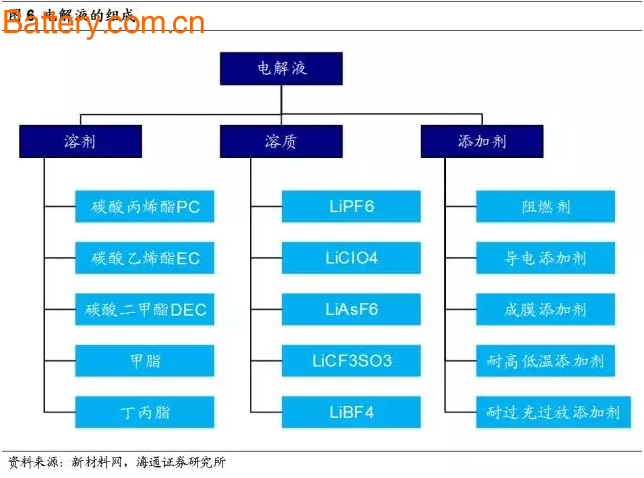
Diaphragm
The main function of the diaphragm is to ensure the free flow of lithium ions in the case of separation of the positive and negative electrodes, which is one of the most important parts to ensure battery safety. The membrane can be immersed in the electrolyte and has a large number of micropores on the surface that allow lithium ions to pass through. Micropore density, as well as material selection, thickness, etc., affect the rate at which lithium ions pass through the separator and affect battery performance. China Industrial Information Network estimates that the consumption of diaphragms in lithium batteries is roughly 20m 2 /kWh.
The diaphragm used by Panasonic to supply Tesla's batteries is supplied by Sumitomo Chemical. Sumitomo Chemical Separator uses a single layer of PE as the base material and is processed by a wet process. Compared with the dry process, the investment cost of the wet process is higher, but the number of micropores on the surface of the film can be increased, and the produced separator is thinner. This is also the biggest advantage of the wet process, the film thickness can be as low as 9μm, and the thickness of the separator produced by the dry process is usually 20-40μm.
Lithium battery structure
As an important part of lithium battery and battery module, precision structural parts mainly include aluminum/steel shell, cover plate and connecting piece, which have direct influence on the safety, airtightness and energy efficiency of lithium battery. Since new energy vehicles require a large number of battery strings and are connected in parallel to ensure energy supply during use, a large number of structural components are required to ensure the safety of the power battery.
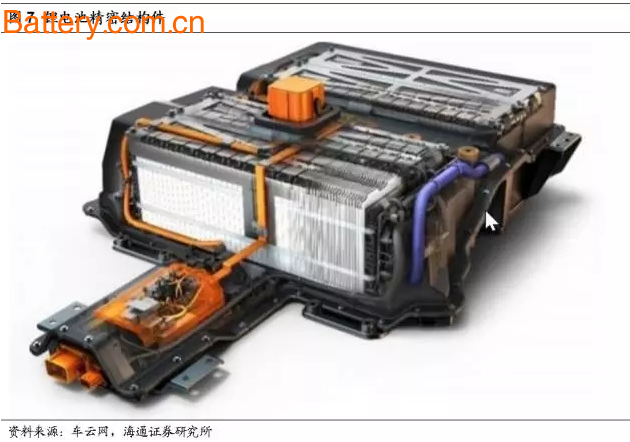

The lithium battery case protects the battery from external damage during storage and use and maintains the internal stability of the battery. It has a direct impact on the safety, sealing and consistency of the battery. It is one of the important components of the lithium battery. Depending on the shape of the lithium battery, the housing materials used are different: the cylindrical battery case is mainly made of steel. The square battery case is mostly made of aluminum shell, and the soft pack battery is mainly packaged with aluminum plastic film and tabs.
The battery contact piece is an important part of the battery and is made of copper, iron, stainless steel and the like. Electroplated gold, silver, nickel, tin. When the battery contact piece mounted on the conductive film is pressed, the center point of the contact piece contacts the battery to form a loop, and current flows. It has the characteristics of strong conductivity and good hand feeling.
At present, under the premise of ensuring the original performance and safety of battery structural components, the lightweight of battery packs is the most important goal of structural parts production. Power battery enterprises are new products and new products for lithium battery precision structural parts manufacturing enterprises. More requirements are put forward in terms of technology and so on. At the same time, more precision structural parts manufacturers are further lightweighting by optimizing the battery system settings.
Tesla 21700 performance cost rolling 18650
Looking back at the beginning of the development of power lithium, Tesla will be widely used in the 3C field to introduce the 18650 into the power lithium battery, opening up a new road for new energy vehicle power. However, the 18650 is limited by volume and key component constraints, generally between 2.2-3.6Ah. At present, the biggest bottleneck of power batteries is still to increase the specific energy, which can compete with traditional fuel vehicles.
Therefore, Tesla's new Model3 will replace the previously mature NCR18650 with a 21700 battery.
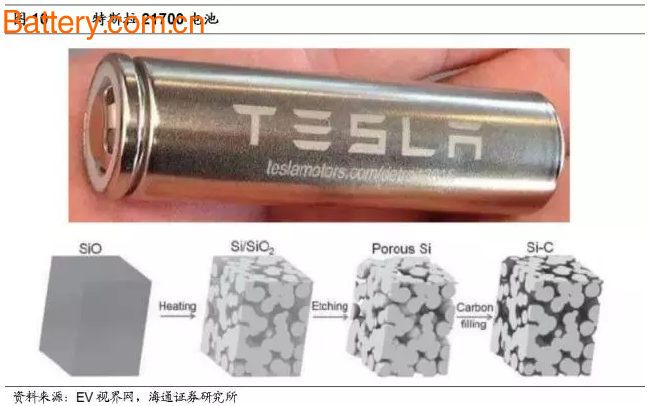
Greater energy density
The 21700 battery has a higher energy density than the 18650 battery. According to the information disclosed by Tesla, under the current conditions, the energy density of the 21700 battery system produced by it is about 300Wh/kg, which is about 20% higher than the 250Wh/kg of its original 18650 battery system, and the capacity will reach 4 .8Ah or so.
The reason is that 21700 is a high-nickel NCA ternary cathode material, and the anode material is upgraded from the original 100% carbon-based material to a carbon-silicon composite material doped with about 10% Si. As mentioned above, the theoretical energy density of Si is much higher than that of graphite, but there are defects that are easy to expand. The 21700 is also the first time to apply a carbon-silicon composite negative electrode to a power battery.

At the same time, because of the increase in energy density, the number of cells required for a battery pack of the same capacity is greatly reduced, the BMS is simpler, the accessories required for PACK are less, and the weight reduction is greatly improved.
Cost does not rise and fall
According to the battery price information disclosed by Tesla, the 21700 power lithium battery system is expected to sell for $170/Wh, which is about 8.1% lower than the 18650 price of $185/Wh. The cost of the 18650 system is about $171/Wh. After switching to 21700, the system cost can be reduced by about 9%, reaching $155/Wh.
After the single-cell capacity is increased, the number of parts required for PACK is reduced in proportion to reduce the cost of PACK. After switching from the 18650 model to the 21700 model, the battery cell capacity can reach 4.8Ah, a substantial increase of 35%, the number of batteries required at the same energy can be reduced by about 1/3, TeslaModels electric vehicle uses 7104 18650 battery series and parallel As a battery pack, it is expected that the number of new MODEL3 battery segments will be greatly reduced. While reducing the difficulty of system management, the same proportion of the number of metal structural parts and conductive connectors used in the battery pack can be reduced.
As the entire battery system is simplified accordingly, the cost is reduced. Tesla's battery accounts for more than 30% of the cost of the entire vehicle, so we expect the cost of the entire vehicle to drop considerably.
Tesla battery industry chain
According to the projection data of seekingalpha, taking Tesla ModelS as an example, its battery system value accounts for 33.23% of the total vehicle cost. In Tesla's battery system, the highest value is undoubtedly a single battery, which can account for 83% of the entire power battery system.
We continue to dismantle the cost of the single-cell battery. Since there is no most accurate data on the Panasonic battery, the industry's estimated power lithium battery data is used as a reference. Among them, the highest proportion is the positive electrode material, generally between 30% and 40%; the separator and electrolyte are between 15% and 20%.
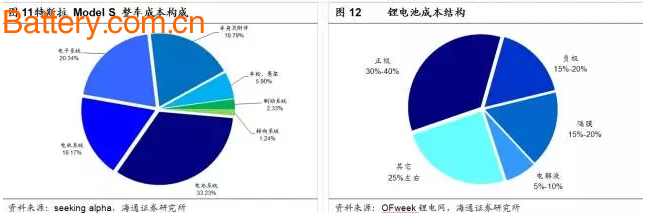
Since Tesla's battery system can be divided into two levels: single battery and battery management system, then the Tesla battery as the origin and traced upstream from these two levels can be combed out. Industry chain.

The rapid development of the new energy automobile industry has provided the most demanding raw material suppliers with an unexpected increase in demand, which is also the core reason for the soaring prices of metals such as cobalt and lithium. Taking Tesla's Panasonic NCA battery as an example, we summarize the consumption of various raw materials analyzed in the previous section. As the penetration rate of new energy vehicles continues to increase in the future, the demand for related raw materials will grow significantly.

Tesla battery industry chain suppliers are fully combed
Matsushita Electric is the sole supplier of Tesla batteries, and the cooperation between the two has started in 2011. In 2013, Tesla and Panasonic renewed their four-year contract, and Panasonic will provide Tesla with about 2 billion batteries in the next four years. Since the capacity of Panasonic batteries is still insufficient to meet the production needs of Tesla, the two signed an agreement in 2014 to jointly establish a Gigafactory battery super factory with an annual production capacity of 35GWh, which is now open in 2016 and is planned to be produced in 2018. Lithium-ion batteries that exceed the combined global production in 2013. Therefore, in the future, Tesla will gradually become self-sufficient in the single battery.
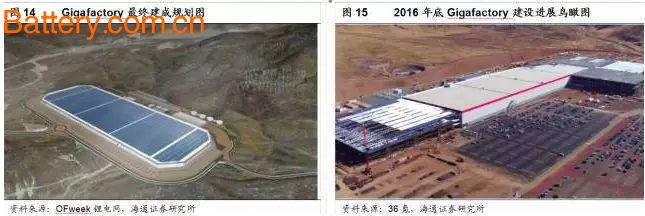
If the Panasonic battery provides the possibility of the endurance and rapid acceleration of the electric vehicle, Tesla's self-developed battery management system will turn this possibility into reality. Tesla BMS provides accurate battery health prediction technology, battery balance management technology, battery residual power management technology, battery thermal management technology, diagnostic and early warning technology. This is a new era in which the BMS makes the electric vehicle's cruising range, battery life and charging time practical, thus opening up the trend of new energy vehicles.
Since Matsushita Electric is a direct supplier of Tesla single cells, the battery management system is independently developed by Tesla. Therefore, to enter the Tesla battery industry chain, you can only adopt the method of becoming a supplier of Panasonic or a certified supplier of Tesla. In this regard, we have carefully combed:
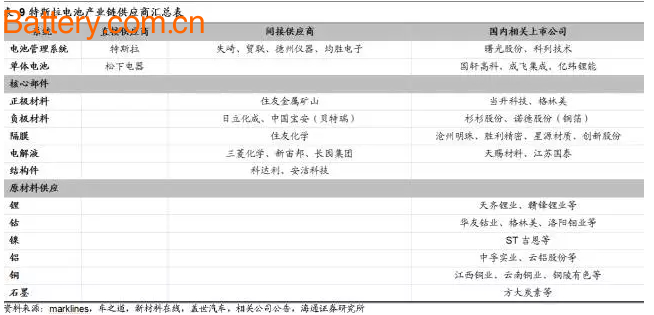
Battery management system
Tesla's battery management system technology is derived from its own patents, while its spare parts have adopted a global procurement strategy. The world's largest automotive wire rod factory, Japan Yazaki, and Taiwan Trade Union provide wire harnesses, the world's largest manufacturer of analog circuit technology components. Texas Instruments offers chip processors.
The domestic average wins the electronics to provide the original sensor for Tesla's battery management system. The company's 2015 annual report information disclosure, the company is the exclusive supplier of BMW in the BMS, and also began to supply some sensor components for Tesla during the reporting period. In 2017, on Tesla's latest off-line Model3, the company's Preh and Gabriel (KSS) were Tesla's airbags, steering wheel and battery charging system. Provide products and technology.
Chang Aluminum shares disclosed on the investor interaction platform on July 10 that the aluminum battery for the power battery cooling system has been applied to Tesla vehicles through the Tesla first-tier supplier.
Single cell
The suppliers of Panasonic batteries are relatively fixed, especially in close cooperation with the Sumitomo Foundation. For example, Sumitomo Metal Mine is responsible for providing cathode materials, and Sumitomo Chemical provides membranes. In other respects, Hitachi Chemical Co., Ltd. is responsible for providing anode materials, and Mitsubishi Chemical provides electrolytes.
At the same time, many companies in the country have obtained the supplier certification of Matsushita Electric Appliance Co., Ltd. to enter the Tesla supply chain. According to the information disclosed by the companies on the public platform, Barrett of China Baoan provides lithium battery anode materials for Panasonic, Xinzhou provides electrolyte for Panasonic, and Jiangsu Huasheng, a subsidiary of Changyuan Group, supplies Panasonic with electrolyte additives.
Due to the establishment of Gigafactory, some companies are also equivalent to supplying parts directly to Tesla. For example, Anjie Technology and its new star supply supply electronic precision components for Panasonic, and Kodali supplies battery connectors for Tesla.
Do you need a high capacity concrete batch plant or require a ready mix plant that will produce higher quality concrete repeatedly to meet precise mix designs? Shine machinery designs and manufactures customized concrete batching plants, also called wet concrete batch plants, that meet any capacity and requirement, whether you're planning to retrofit existing facilities or start from the ground up. Shine machinery designs and produces high technology concrete batch plants(mobile and stationery, wet and dry), our ready concrete mix plants are intended for both domestic and international concrete producers and contractors. From the design and specifications stages to the manufacturing, installation and commissioning of the ready mix plant, the Shine machinery experts will guide you through the process until your Concrete Plant is up and running. The new type of No Foundation Concrete Batching Plant is a Concrete Batching Plant that can act as Mobile Concrete Batching Plant when it is trailed by tow truck. Besides this type of concrete Batching Plant can also work in one site to produce concrete to meet the customer's need.
40 No Foundation Concrete Batching Plant
40 No Foundation Concrete Batching Plant,Wet Concrete Batching Station,Wet Mobile Concrete Mix Machine,Dry Concrete Batching Plant
Shandong Shenghuai Trading Co., Ltd. , https://www.shinebatchplant.com